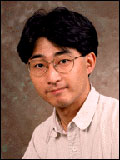|
|
|||||
|
|
Understanding the Link Between Mass and Energy
Theoretical Physicist Hitoshi Murayama Will Discuss Impact of E=mc2 in Buhl Lecture, April 21
This famous equation, part of the theory of relativity set forth by Einstein in April 1905, changed our understanding of nature at the most fundamental level. "c" is the speed of light. It is the ultimate speed in the universe; nothing can go faster. "m" stands for mass. For centuries after Newton it was believed that mass is absolute. But this equation of Einstein revealed that mass is yet another form of energy that can change to other forms—kinetic, gravitational, chemical, thermal, nuclear—and back again to mass. An electron and an anti-electron annihilate into pure energy; in turn, energy can create matter and anti-matter. The fascinating story of energy and mass is still evolving a century since Einstein as we understand more of where they come from, how they shape the universe, and the missing pieces of the universe: Dark Matter and Dark Energy.
Murayama is the MacAdams Professor of Physics at the University of California, Berkeley. He has spent the last academic year at the Institute for Advanced Study in Princeton. He received the Yukawa Commemoration Prize in Theoretical Physics in 2002. His theoretical work has spanned a broad range of topics at the forefront of particle physics. These include the properties of neutrinos, which may help explain the abundance of matter and dearth of anti-matter in our universe, and Dark Energy and its relationship to theories that give rise to mass for elementary particles.
Murayama serves on the Fermilab Physics Advisory Committee and has been deeply involved in defining the future program of particle physics research in the United States.
The Buhl Lecture is sponsored by Carnegie Mellon's Department of Physics and is funded under the auspices of the Buhl Professorship in Theoretical Physics, which was established at Carnegie Mellon in 1961 by The Buhl Foundation. For more information, please contact Carnegie Mellon's Department of Physics at 412-268-6681.
Lauren Ward |
|||
|
Carnegie Mellon Home |
|||||
